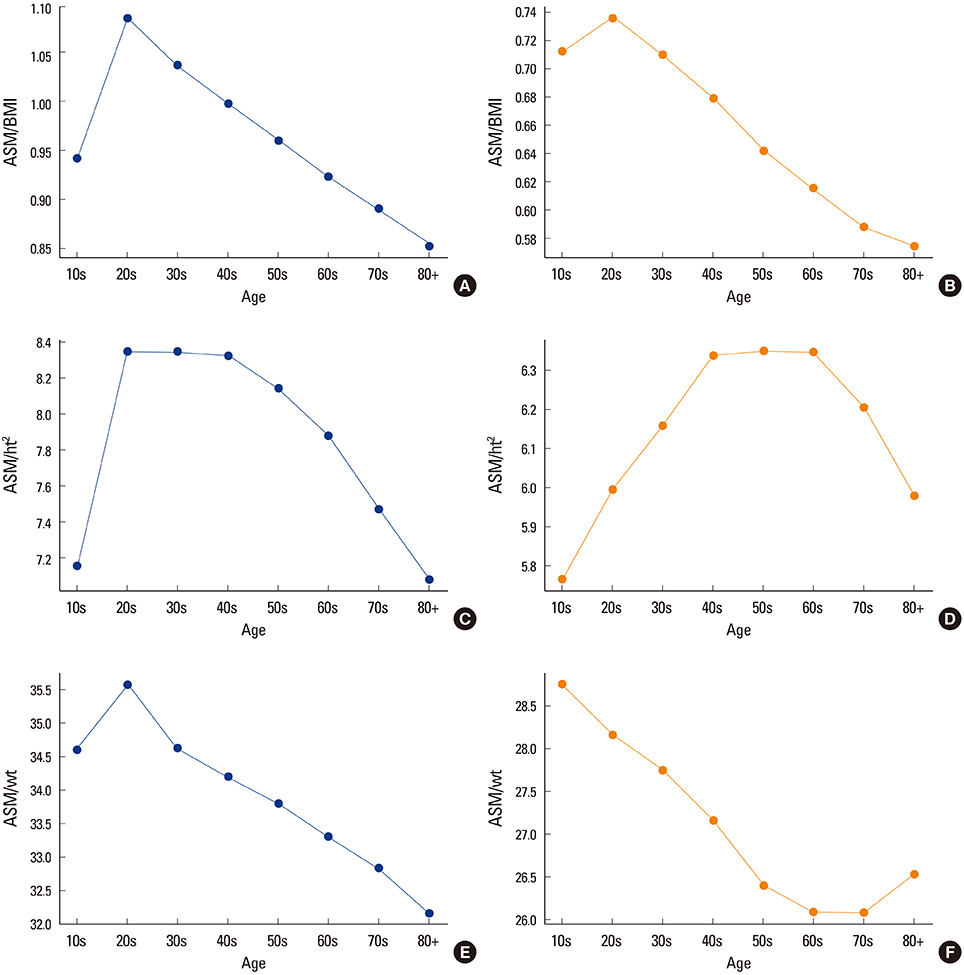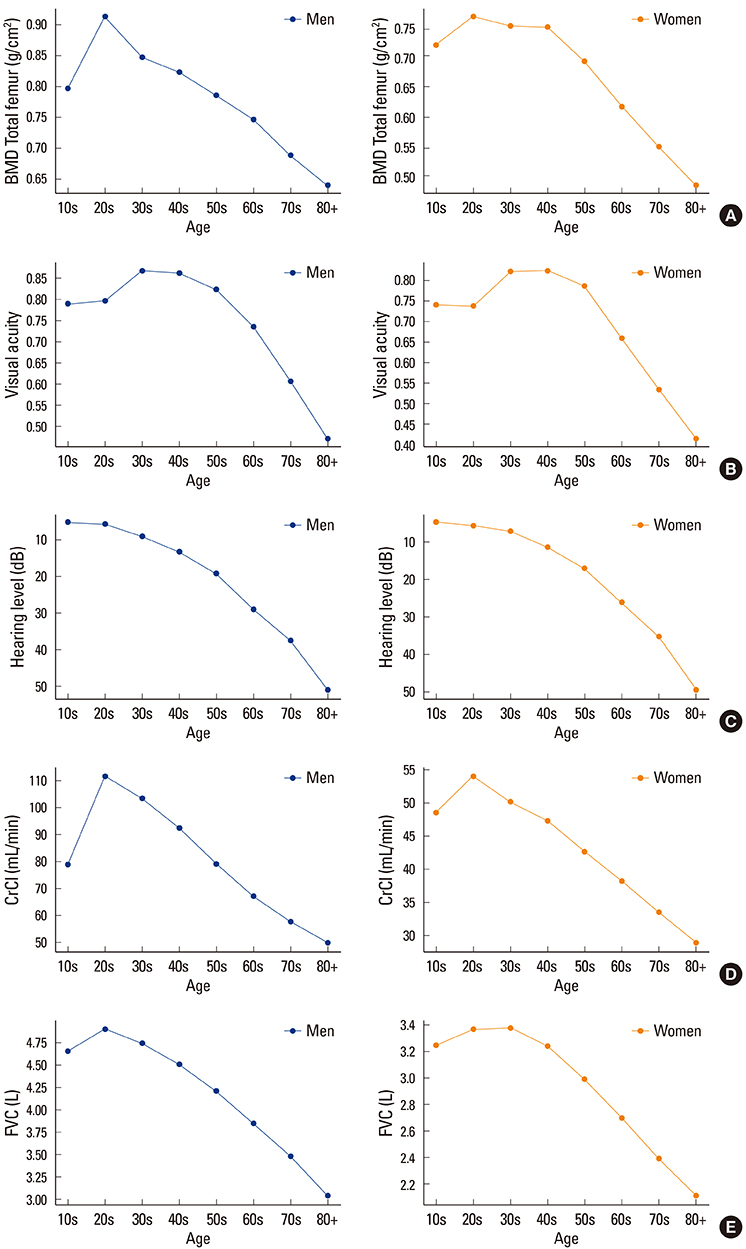J Bone Metab.
2018 Nov;25(4):219-226. 10.11005/jbm.2018.25.4.219.
Which Index for Muscle Mass Represents an Aging Process?
- Affiliations
-
- 1Department of Orthopaedic Surgery, Seoul National University Bundang Hospital, Seoul National University College of Medicine, Seongnam, Korea. ykleemd@gmail.com
- 2Department of Internal Medicine, Center for Thyroid Cancer, National Cancer Center, Goyang, Korea.
- KMID: 2427987
- DOI: http://doi.org/10.11005/jbm.2018.25.4.219
Abstract
- BACKGROUND
Although studies and interest in sarcopenia have increased, it is still a matter of debate which muscle mass index better represents the aging process. We compared 3 indices for muscle mass (appendicular skeletal muscle mass [ASM]/weight, ASM/height2, and the body mass index [BMI]-adjusted muscle mass index [ASM/BMI]) to determine which better reflected the aging process in terms of the decline in bone mineral density (BMD), visual acuity (VA), hearing power, renal function, pulmonary function, and handgrip strength.
METHODS
We performed a retrospective cross-sectional study using the Korea National Health and Nutrition Examination Survey in the Korean population. Between 2008 and 2011, a total of 14,415 men and 17,971 women aged 10 years or older participated in the study. We plotted the changes in the 3 indices of muscle mass and compared these with changes in BMD, VA, hearing power, renal function, pulmonary function, and handgrip strength according to each age group.
RESULTS
The ASM/BMI showed similar changes in terms of surrogate markers of the aging process, while the ASM/weight and ASM/height2 showed no correlation.
CONCLUSIONS
Among muscle indices for sarcopenia, only the ASM/BMI represented the aging process.
Keyword
MeSH Terms
Figure
Reference
-
1. Rosenberg IH, Roubenoff R. Stalking sarcopenia. Ann Intern Med. 1995; 123:727–728.
Article2. Baumgartner RN, Koehler KM, Gallagher D, et al. Epidemiology of sarcopenia among the elderly in New Mexico. Am J Epidemiol. 1998; 147:755–763.
Article3. Landi F, Liperoti R, Fusco D, et al. Sarcopenia and mortality among older nursing home residents. J Am Med Dir Assoc. 2012; 13:121–126.
Article4. Amigues I, Schott AM, Amine M, et al. Low skeletal muscle mass and risk of functional decline in elderly community-dwelling women: the prospective EPIDOS study. J Am Med Dir Assoc. 2013; 14:352–357.
Article5. Gao L, Jiang J, Yang M, et al. Prevalence of sarcopenia and associated Factors in Chinese community-dwelling elderly: comparison between rural and urban areas. J Am Med Dir Assoc. 2015; 16:1003.e1–1003.e6.
Article6. Bae EJ, Kim YH. Factors affecting sarcopenia in Korean adults by age groups. Osong Public Health Res Perspect. 2017; 8:169–178.
Article7. Moon SS. Low skeletal muscle mass is associated with insulin resistance, diabetes, and metabolic syndrome in the Korean population: the Korea National Health and Nutrition Examination Survey (KNHANES) 2009-2010. Endocr J. 2014; 61:61–70.
Article8. Landi F, Onder G, Bernabei R. Sarcopenia and diabetes: two sides of the same coin. J Am Med Dir Assoc. 2013; 14:540–541.
Article9. Leenders M, Verdijk LB, van der Hoeven L, et al. Patients with type 2 diabetes show a greater decline in muscle mass, muscle strength, and functional capacity with aging. J Am Med Dir Assoc. 2013; 14:585–592.
Article10. Morley JE, Malmstrom TK, Rodriguez-Mañas L, et al. Frailty, sarcopenia and diabetes. J Am Med Dir Assoc. 2014; 15:853–859.
Article11. Hirani V, Blyth F, Naganathan V, et al. Sarcopenia is associated with incident disability, institutionalization, and mortality in community-dwelling older men: the concord health and ageing in men project. J Am Med Dir Assoc. 2015; 16:607–613.
Article12. Morley JE, Abbatecola AM, Argiles JM, et al. Sarcopenia with limited mobility: an international consensus. J Am Med Dir Assoc. 2011; 12:403–409.
Article13. Pfortmueller CA, Lindner G, Exadaktylos AK. Reducing fall risk in the elderly: risk factors and fall prevention, a systematic review. Minerva Med. 2014; 105:275–281.14. Fielding RA, Vellas B, Evans WJ, et al. Sarcopenia: an undiagnosed condition in older adults. Current consensus definition: prevalence, etiology, and consequences. International working group on sarcopenia. J Am Med Dir Assoc. 2011; 12:249–256.
Article15. Cesari M, Vellas B. Sarcopenia: a novel clinical condition or still a matter for research? J Am Med Dir Assoc. 2012; 13:766–767.
Article16. Cruz-Jentoft AJ, Baeyens JP, Bauer JM, et al. Sarcopenia: European consensus on definition and diagnosis: Report of the European Working Group on Sarcopenia in Older People. Age Ageing. 2010; 39:412–423.
Article17. Janssen I, Heymsfield SB, Ross R. Low relative skeletal muscle mass (sarcopenia) in older persons is associated with functional impairment and physical disability. J Am Geriatr Soc. 2002; 50:889–896.
Article18. Chen LK, Liu LK, Woo J, et al. Sarcopenia in Asia: consensus report of the Asian Working Group for Sarcopenia. J Am Med Dir Assoc. 2014; 15:95–101.
Article19. Studenski SA, Peters KW, Alley DE, et al. The FNIH sarcopenia project: rationale, study description, conference recommendations, and final estimates. J Gerontol A Biol Sci Med Sci. 2014; 69:547–558.
Article20. Mijnarends DM, Meijers JM, Halfens RJ, et al. Validity and reliability of tools to measure muscle mass, strength, and physical performance in community-dwelling older people: a systematic review. J Am Med Dir Assoc. 2013; 14:170–178.
Article21. Kim KM, Jang HC, Lim S. Differences among skeletal muscle mass indices derived from height-, weight-, and body mass index-adjusted models in assessing sarcopenia. Korean J Intern Med. 2016; 31:643–650.
Article22. Coin A, Sarti S, Ruggiero E, et al. Prevalence of sarcopenia based on different diagnostic criteria using DEXA and appendicular skeletal muscle mass reference values in an Italian population aged 20 to 80. J Am Med Dir Assoc. 2013; 14:507–512.
Article23. Lee WJ, Liu LK, Peng LN, et al. Comparisons of sarcopenia defined by IWGS and EWGSOP criteria among older people: results from the I-Lan longitudinal aging study. J Am Med Dir Assoc. 2013; 14:528.e1–528.e7.
Article24. Jin YH. A new LogMAR vision chart: Jin's vision chart. J Korean Ophthalmol Soc. 1997; 38:2036–2044.25. Suh YW, Lee JS, Heo H, et al. Vision improvement with refractive correction does not completely exclude major eye diseases: analyses of visually impaired South Korean population in the Korea National Health and Nutrition Examination Survey 2009-2011. J Ophthalmol. 2017; 2017:3412904.
Article26. Lee J, Han K, Song JJ, et al. Sarcopenia and hearing loss in older Koreans: findings from the Korea national health and nutrition examination survey (KNHANES) 2010. PLoS One. 2016; 11:e0150281.
Article27. Cockcroft DW, Gault MH. Prediction of creatinine clearance from serum creatinine. Nephron. 1976; 16:31–41.
Article28. American Thoracic Society. Standardization of Spirometry, 1994 Update. Am J Respir Crit Care Med. 1995; 152:1107–1136.29. Choi JK, Paek D, Lee JO. Normal predictive values of spirometry in Korean population. Tuberc Respir Dis. 2005; 58:230–242.
Article30. Kwak Y, Kim Y. Quality of life and subjective health status according to handgrip strength in the elderly: a cross-sectional study. Aging Ment Health. 2017; DOI: 10.1080/13607863.2017.1387766.
Article31. Roh YH, Noh JH, Gong HS, et al. Effect of low appendicular lean mass, grip strength, and gait speed on the functional outcome after surgery for distal radius fractures. Arch Osteoporos. 2017; 12:41.
Article32. Heymsfield SB, Gonzalez MC, Lu J, et al. Skeletal muscle mass and quality: evolution of modern measurement concepts in the context of sarcopenia. Proc Nutr Soc. 2015; 74:355–366.
Article33. Gallagher D, DeLegge M. Body composition (sarcopenia) in obese patients: implications for care in the intensive care unit. JPEN J Parenter Enteral Nutr. 2011; 35:21s–28s.34. Abe T, Thiebaud RS, Loenneke JP, et al. Influence of severe sarcopenia on cardiovascular risk factors in nonobese men. Metab Syndr Relat Disord. 2012; 10:407–412.
Article35. Jeon YK, Shin MJ, Kim MH, et al. Low pulmonary function is related with a high risk of sarcopenia in community-dwelling older adults: the Korea National Health and Nutrition Examination Survey (KNHANES) 2008-2011. Osteoporos Int. 2015; 26:2423–2429.
Article36. Newman AB, Kupelian V, Visser M, et al. Sarcopenia: alternative definitions and associations with lower extremity function. J Am Geriatr Soc. 2003; 51:1602–1609.
Article37. Estrada M, Kleppinger A, Judge JO, et al. Functional impact of relative versus absolute sarcopenia in healthy older women. J Am Geriatr Soc. 2007; 55:1712–1719.
Article38. McLean RR, Shardell MD, Alley DE, et al. Criteria for clinically relevant weakness and low lean mass and their longitudinal association with incident mobility impairment and mortality: the foundation for the National Institutes of Health (FNIH) sarcopenia project. J Gerontol A Biol Sci Med Sci. 2014; 69:576–583.
Article39. Moon JH, Kim KM, Kim JH, et al. Predictive values of the new sarcopenia index by the foundation for the national institutes of health sarcopenia project for mortality among older Korean adults. PLoS One. 2016; 11:e0166344.
Article
- Full Text Links
- Actions
-
Cited
- CITED
-
- Close
- Share
- Similar articles
-
- Sarcopenia and Sarcopenic Obesity
- Differences among skeletal muscle mass indices derived from height-, weight-, and body mass index-adjusted models in assessing sarcopenia
- Sarcopenia and Neurosurgery
- Resistance Exercise Strategies for Sarcopenic Obesity in Elderly People
- Strengthening Exercise for Prevention of Sarcopenia during the Aging Process




